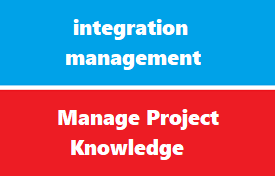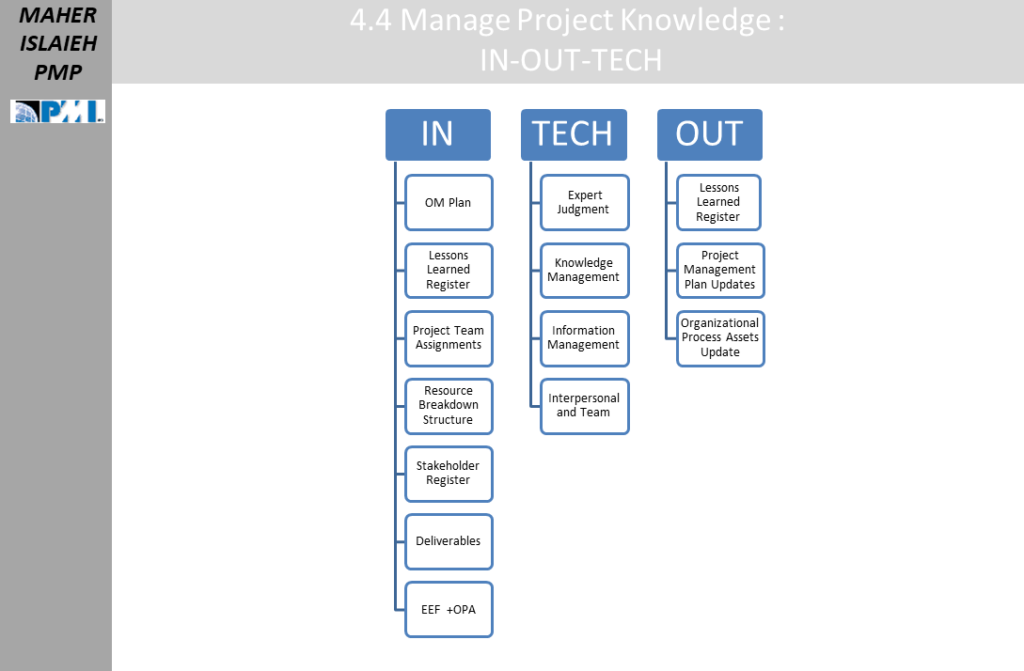introduction
process ( Manage Project Knowledge ) is new process to PMBOK 6th edition
let us to discuss the concepts
Manage Project Knowledge
Manage Project Knowledge is a new project management process added to the PMBOK Guide, 6th Edition. It reflects an increased focus on managing knowledge throughout the project.
Following are the key points about the Manage Project Knowledge process.
- The Manage Project Knowledge process has primarily two purposes – reusing existing knowledge and creating new knowledge. Knowledge captured in the past is used to improve performance on the current project, and the knowledge created by the current project is made available to future projects.
- This process is performed throughout the project.
- Manage Project Knowledge is concerned with managing both explicit and tacit knowledge (refer to study notes below).
- You cannot force people to share everything that they know. Even the best knowledge management tools will not help unless people feel motivated to share their knowledge. Therefore it is important to create an environment of collaboration and trust so that people feel intrinsically motivated to share their knowledge with their colleagues.
process input-tools-techniques-outputs
IN
- Project Management Plan
- Lessons Learned Register
- Project Team Assignments
- Resource Breakdown Structure
- Stakeholder Register
- Deliverables
- Enterprise Environmental Factors
- Organizational Process Assets
TECH
- Expert Judgment
- Knowledge Management
- Information Management
- Interpersonal and Team
OUT
- Lessons Learned Register
- Project Management Plan Updates
- Organizational Process Assets Update
Project Documents
Project Documents :
Lessons Learned Register
The lessons learned register provides information on effective practices in knowledge management.
Project Team Assignments
Project team assignments provide information on the type of competencies and experience available in the project and the knowledge that may be missing.
Resource Breakdown Structure
The resource breakdown structure includes information on the composition of the team and may help to understand what knowledge is available as a group and what knowledge is missing.
Stakeholder Register
The stakeholder register contains details about the identified stakeholders to help understand the knowledge they may have.
Deliverables
Deliverables are typically tangible components completed to meet the project objectives and can include components of the project management plan. Some knowledge may be embedded in deliverables.
Enterprise Environmental Factors
Relevant EEFs include:
- Organizational, stakeholder, and customer culture – trusting working relationships, a no-blame culture and value placed on learning and social behavioral norms are important factors in managing knowledge
- Geographic distribution of facilities and resources – the location of team members helps determine methods for gaining and sharing knowledge
- Organizational knowledge experts
- Legal and regulatory requirements and/or constraints (such as those related to confidentiality of project information)
Organizational Process Assets
Relevant OPAs include:
- Organizational policies, processes, and procedures – e.g. confidentiality and access to information; security and data protection; record retention policies; use of copyrighted information; destruction of classified information; format and maximum size of files; registry data and metadata; authorized technology and social media; etc.
- Personnel administration – e.g. employee development and training records, and competency frameworks that refer to knowledge-sharing behaviors
- Organizational communication requirements
- Formal knowledge-sharing and information-sharing procedures
Expert Judgment
Expertise should be sought in:
- Knowledge management
- Information management
- Organizational learning
- Knowledge and information management tools
- Relevant information from other projects
Knowledge Management
Networking (including informal social interaction and online social networking), communities of practice, meetings (including virtual meetings), work shadowing, focus groups, seminars and conferences, workshops and storytelling are some of the common knowledge management tools and techniques.
Face-to-face interaction is usually the most effective way to build the trusting relationships that are needed to manage knowledge.
Information Management
Information management tools and techniques are used to create and connect people to information. Methods for codifying explicit knowledge, lessons learned register, library services, information gathering (e.g. web searches and reading published articles), and project management information system (PMIS) are common information management tools and techniques.
Interpersonal and Team Skills
Active Listening
Active listening helps reduce misunderstandings and improves communication and knowledge sharing.
Facilitation
- Facilitation helps effectively guide a group to a successful decision, solution, or conclusion.
Leadership
- Leadership is used to communicate the vision and inspire the project team to focus on the appropriate knowledge and knowledge objectives.
Networking
- Networking allows informal connections and relations among project stakeholders to be established and creates the conditions to share tacit and explicit knowledge.
Political Awareness
- Political awareness helps the project manager to plan communications based on the project environment as well as the organization’s political environment.
Process Outputs
Lessons Learned Register
- The lessons learned register can include the category, description, impact, recommendations, and proposed actions associated with a situation. It may also record challenges, problems, realized risks and opportunities. It is first created in this process and thereafter used as an input and updated as an output in many processes throughout the project.
Project Management Plan Updates
- Any component of the project management plan may be updated as a result of this process.
Organizational Process Assets Updates
- Knowledge created in this process may lead to improvements to processes and procedures. Any organizational process asset can be updated as a result of this process.


